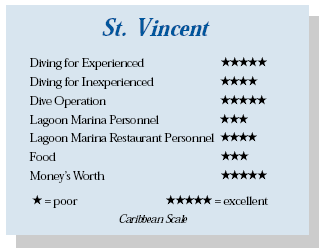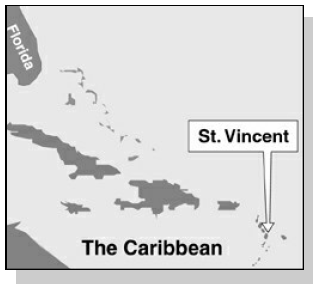St. Vincent, West IndiesContents of this Issue: REEF’s Science Saves the Goliath Grouper Brand New Paul Humann ID Books Get Rid of Your Pesos and Help the Kids Picking Up the Pieces: The Misadventures of Tropical Adventure s New Free Service for Subscribers Diving in Florida or the Caribbean This Spring? G reat White Sharks Migrate Thousands of Miles Editorial Office: Ben Davison Publisher and Editor Undercurrent 3020 Bridgeway, Suite 102 Sausalito, CA 94965 muck diving with REEF from the March, 2002 issue of Undercurrent
Dear Fellow Diver: Plenty of colorful sponges, hard and soft corals. The usual run of damselfish, wrasses, and butterflyfishes. A normal beginning to a relaxing Caribbean dive, it would seem. But this dive was different. Our buddy pairs were eagerly looking around and marking on yellow slates with plastic fish ID cards attached, pointing and consulting with each other ... just like birdwatchers, but in rubber, not khaki. This was REEF’s (Reef Environmental and Education Foundation) December 2001 fish survey in St. Vincent. At “The Steps,” I documented the species and abundance of fishes and general reef conditions. The data will be used by divers, dive operators, scientists, and perhaps, as in Bonaire and the Keys, government entities deciding reef preservation. By the end of the week, the six of us had spent more than 125 hours underwater collecting data. And, I myself developed a keen eye for locating such fish as yellowface and bluethroated pikeblennies, scorpionfishes, leatherjackets, and even the various tiny gobies in corals and sponges and shy blennies hiding in wormholes. Armed with this skill, Caribbean diving just became a hell of a lot more fun. REEF is a nonprofit organization of recreational
divers who conduct fish biodiversity and abundance surveys.
It was started in 1990 by critter gurus Paul Humann and Ned
DeLoach. While a cynic might see REEF as a vehicle to sell
their three ID books, Humann and DeLoach see it as an
opportunity to educate and involve divers in documenting and
preserving the reefs we all love. Though most large fish species are scarce (65 percent unemployment and hungry bellies are the main reason), the reefs are healthy and diverse, a dessert frosted with critters rare and wonderful. On one dive, descending onto the top of “The Wall,” I saw the “cover girl” of Humann’s Fish ID book, a brilliant golden hamlet, with fluorescent blue lines etched on its black-masked face. After observing and marking my slate, I slipped over a steep slope where at 80 feet divers were peering under a deep ledge to ogle large, yellowcheek basslets illuminated by ethereal light beams. Divers made weird noises in their regulators as one pointed out a large, stationary black brotula! It was just an “ugly, eel-shaped fish” to some, but a grail to others . (By the time we left St. Vincent, I had seen several of these, including a dainty juvenile in a discarded oil drum -- and several multi-hued frogfish, seahorses, pipefish and pipehorses.) An hour later, unloading nitrogen at the end of the dive, a trumpetfish let me gently rub his belly. I saw pencil-thin chestnut moray, redeyed triplefins, and tusked gobies. Although a couple divers reported mantas at 145 feet, I saw nothing big, but it was an outstanding dive with gin-clear water, healthy corals and sponges, and scads of fish -- many rare, many common, like the endless cobalt stream of Creole wrasse that passed by. By the end of this dive, I’d seen three golden hamlets and many of its less colorful cousins (shy, yellowbelly, yellowtailed, barred and even one hybrid). Bill Tewes is a real diver’s kind of guy. With eighteen years at St. Vincent,
one afternoon at Critter Corner, he announced his 305th dive of the year! For critter
connoisseurs, Bill has developed muck diving of the kind I enjoyed in Papua New
Guinea -- where, not without coincidence, he operated a dive resort before moving to
St. Vincent. If you haven’t been muck diving, you might wonder about the site when
you hit the water. But, 30 feet down on the sand bottom, critters were everywhere:
in clumps of turtle grass, on a few rocks and in discarded tires, and in old chicken
coop. A very excited Bill waved in doubting divers, pointing with a radio antenna
and light beam to a small rock. I thought it was only a spotted moray with a huge
arrow crab, but then a corkscrew anemone, hmm. A pistol shrimp pair, wow... two
rusty gobies... and what was that, a sawcheek cardinal, living symbiotically with
the anemone... and a small mushroom’scorpionfish! And that’s just one small rock.
But, what’s that across the turtlegrass? A solitary, somewhat used-looking sea finger,
all bumpy and lumpy.... with eyes? Hey, a longlure frogfish in the crook, same
color as the orange sponge. And two flying gurnards, that everyone could approach
and shoot. Bill stuck a mirror in the sand. A bluethroated pikeblenny reared up out of its hole in all its fury, raising its
dorsal fin and enlarging its brilliant
gular pouch to fight off the mirror-image
invader! Because it was just the two of us, it was our own private dive and we called the sites. Bearded Bill himself was often the dive guide -- this guy loves to dive so much he’d leave his staff on pay at the shop to take two of us out. He’s short and wiry and dives in a bathing suit and T-shirt. His sense of humor is so dry there’s no need for those Peter Hughes towels with this dive op (BYO). He knows everyone, and even appears on St. Vincent country’s postage stamps -- along with other marine life. Our usual drill was to be picked up by car for a quick trip to the shop (or by boat when with other divers) about 9 a.m. Times and sites were decided after consulting with divers. Our return was after 2 p.m., with leisurely surface intervals and l-o-n-g dives. Even with some dives to 130 feet, my average dive time for 26 dives was 1:26, facilitated by water temps of 84 degrees F. However, Bill asks people not to suck his tanks down to Coke bottle shape. Don Carlos “D. J.” Jack a pleasant, low key dive guide with many a good photo to his credit, helped with photogenic critter finding, camera handling and assistance. Night dives are not to be missed, with lots of color and more unimaginablecritters than daytime, and various species of moray and other eels, scorpions and fishes meandering about. Callie (Calvert) Richards is the “night dive” specialist. He looks like a very fit football player, but has been at DSV 16 years and knows dive sites like he knows the nooks in his house. His eyes are sharp; he has a quiet sense of humor and lots of knowledge -- but like most Vincentians, it takes building a relationship and encouragement to get him to open up. The verdant, mountainous island supports a culture that is friendly, welcoming and authentically Vincentian. Hire a driver or use the ubiquitous “dollar van” taxis to visit nearby Kingstown, the capital, where in the hemisphere’s oldest botanical gardens you can see descendants of Captain Bligh’s infamous breadfruit trees. The old Fort Charlotte has fabulous views of Kingstown; here are the women’s prison and gallows, still used on the rare murderer. There is hiking and birding, as well as world-class deep sea fishing, sailing and excursions to other islands in the chain. The only nighttime activity to speak of is the weekly “Culture Corner” street festival every Friday night -- good local eats, music and friendly Vincentians eager to share. While there are better accommodations on St. Vincent, REEF used the economical Lagoon Marina (five miles from the airport, three from the dive shop). The ground floor includes offices and workshops, reception and a market suited to yachties. Upstairs is the Terrace Green Flash Bar and Restaurant, and 19 rooms with water and marina views. The air-conditioned rooms are clean and well maintained, have spacious terraces, a phone and TV (which purports to provide Internet services, but “it isn’t wo rking this week”). Rooms near the center can get bar noise at night and boat maintenance noise in the morning . With limited restaurant hours and leisurely dives, we often returned after lunch hours -- so we ate “bar food” at the Green Flash -- excellent hamburgers, fish, salads and shrimp dishes. At the restaurant, the meals were very good at times, but at other times they were out of even basic foodstuffs. Sometimes, the usual chef was absent and those who filled in were about as capable as my college roommates. One day we’d have exotic Caribbean breakfast fare, such as coconut, rum and cinnamon French toast, or tropical fruit pancakes. The next day, the bread would be stale, they would be out of bacon, and the over-cooked fried eggs could have been used for “Bott’s dots,” which keep you in your lane on highways! Even coffee and hot chocolate varied from delicious to deplorable. Evening meals were best -- our favorite were the marvelous lobsters with fries and sweet potatoes, garnishes and sauce, the good, local Hairoun beer and last but not least, excellent coconut ice cream -- for US $20! Red snapper with veggies cost US $13. The usual servers were friendly and helpful, but when others filled in, the glacial service was hit or miss. We often traveled to one of several other restaurants. Near the dive shop the friendly Lime Pub had a huge variety of tasty drinks and viands for hungry divers. At the end of a REEF trip some have been heard to say, “Man! Dives in the morning, seminars in the afternoon, fill out the scan forms after the dives, and finally the test! It’s too much like work!” Though, the next words are often “Hey, they’re doing Midway Island next year -- are you thinking of going?” This was my third REEF group survey, and I’m already looking over the list for 2002 (you can see it too, at http://www.reef.org/data/surveyproject.htm. And, as a final bonus, some survey trips are led by founders Humann or DeLoach... and that can make the trips a real treat. But, if you’re not into the organized REEF program, enjoy St. Vincent and Bill Tewes’ operation on your own. It’s among the best the Caribbean has to offer. - - L . J . |

I want to get all the stories! Tell me how I can become an Undercurrent Online Member and get online access to all the articles of Undercurrent as well as thousands of first hand reports on dive operations world-wide
| Home | Online Members Area | My Account |
Login
|
Join
|
| Travel Index |
Dive Resort & Liveaboard Reviews
|
Featured Reports
|
Recent
Issues
|
Back Issues
|
|
Dive Gear
Index
|
Health/Safety Index
|
Environment & Misc.
Index
|
Seasonal Planner
|
Blogs
|
Free Articles
|
Book Picks
|
News
|
|
Special Offers
|
RSS
|
FAQ
|
About Us
|
Contact Us
|
Links
|
3020 Bridgeway, Ste 102, Sausalito, Ca 94965
All rights reserved.

 And they’ve worked hard
without compensation to see that REEF does just that. With
five paid staff (including a scientist in the Northwest) and
scads of volunteers, REEF divers have made 40,000 surveys in the Atlantic, Caribbean, Eastern Pacific,
the Galapagos and the Pacific Northwest.
Divers can move through five levels,
according to training, experience and
testing. Trained divers can join organized
REEF surveys or collect data on
their own, but they are to document only
those species they can positively identify
-- no guessing here. On each dive,
they document Abundance: Single, Few
(2-10), many (11-100), or Abundant (more
than 100). The data is verified and
posted for public access at
And they’ve worked hard
without compensation to see that REEF does just that. With
five paid staff (including a scientist in the Northwest) and
scads of volunteers, REEF divers have made 40,000 surveys in the Atlantic, Caribbean, Eastern Pacific,
the Galapagos and the Pacific Northwest.
Divers can move through five levels,
according to training, experience and
testing. Trained divers can join organized
REEF surveys or collect data on
their own, but they are to document only
those species they can positively identify
-- no guessing here. On each dive,
they document Abundance: Single, Few
(2-10), many (11-100), or Abundant (more
than 100). The data is verified and
posted for public access at  Here were black-red urchins,
mantis shrimps, snake eels, pipehorses,
whitefaced pipefish, mutton hamlets and
juvenile queen angels cleaning other
fish. At first glance it was a desert,
but careful eyeballing revealed a dessert
for critter-savvy divers, every bit as
good as “Dinah’s Beach” in PNG. After
more than 90 minutes underwater, most
divers were clamoring for more! One group
spent nine of 12 St. Vincent dives here
at “Critter Corner” -- though there is no
shortage of pristine and varied dive
sites, most within a 15 minute cruise.
Bill’s operation rinsed and stored our
gear, asked what we wanted to see, and
allowed us to stay as long as our steel
tanks (72s and 80s) and judgment permitted. Bill offers an all-day trip to the picturesque
Falls of Baleine, including an on-your-own lunch at a native restaurant,
two remote dives and Bill’s notorious “jet fuel” rum punch after the dives. Our
trip, which I took after my REEF commitment ended, included a second crew member,
Larry , the new guy with “only” six years on staff. His friendly face and demeanor
belie his boat maintenance skills, and he is a willing model for our video or photo
sessions. This trip was on one of DSV’s two smaller other boats, twin powered 23-and
28-foot speedboats, looking like ski boats, to make the long trip up coast faster. I
enjoyed two healthy dives here -- the aptly named “Coral Castle,” and “Dark Head.”
There were steeply sloping walls, sand chutes and lots of subtidal rock and encrustations,
with the usual suspects, a single ‘cuda, as well as a frogfish swimming and
climbing about, seahorses, huge whitenose pipefish, and dark gurnards. Most of our
diving was from DSV’s largest, a seaworthy 30-foot twin-engine semi-cabin with a
hinged tube “U” diving ladder. Gear and tanks are stowed forward in the cuddy;
divers sit on side row seats under shelter or in the sun. After the crew helped me
with my gear, I simply rolled off the gunwales. Egress means moving up the current
line and handing up your gear. Bottled drinking water is provided, along with an
interminable supply of hard candies. With eight, this boat feels “full up,” but most
dive sites are within minutes with the power of the new twin 200 HP well-tuned, nonpolluting
Yammies.
Here were black-red urchins,
mantis shrimps, snake eels, pipehorses,
whitefaced pipefish, mutton hamlets and
juvenile queen angels cleaning other
fish. At first glance it was a desert,
but careful eyeballing revealed a dessert
for critter-savvy divers, every bit as
good as “Dinah’s Beach” in PNG. After
more than 90 minutes underwater, most
divers were clamoring for more! One group
spent nine of 12 St. Vincent dives here
at “Critter Corner” -- though there is no
shortage of pristine and varied dive
sites, most within a 15 minute cruise.
Bill’s operation rinsed and stored our
gear, asked what we wanted to see, and
allowed us to stay as long as our steel
tanks (72s and 80s) and judgment permitted. Bill offers an all-day trip to the picturesque
Falls of Baleine, including an on-your-own lunch at a native restaurant,
two remote dives and Bill’s notorious “jet fuel” rum punch after the dives. Our
trip, which I took after my REEF commitment ended, included a second crew member,
Larry , the new guy with “only” six years on staff. His friendly face and demeanor
belie his boat maintenance skills, and he is a willing model for our video or photo
sessions. This trip was on one of DSV’s two smaller other boats, twin powered 23-and
28-foot speedboats, looking like ski boats, to make the long trip up coast faster. I
enjoyed two healthy dives here -- the aptly named “Coral Castle,” and “Dark Head.”
There were steeply sloping walls, sand chutes and lots of subtidal rock and encrustations,
with the usual suspects, a single ‘cuda, as well as a frogfish swimming and
climbing about, seahorses, huge whitenose pipefish, and dark gurnards. Most of our
diving was from DSV’s largest, a seaworthy 30-foot twin-engine semi-cabin with a
hinged tube “U” diving ladder. Gear and tanks are stowed forward in the cuddy;
divers sit on side row seats under shelter or in the sun. After the crew helped me
with my gear, I simply rolled off the gunwales. Egress means moving up the current
line and handing up your gear. Bottled drinking water is provided, along with an
interminable supply of hard candies. With eight, this boat feels “full up,” but most
dive sites are within minutes with the power of the new twin 200 HP well-tuned, nonpolluting
Yammies. Diver’s Compass: This REEF trip included 10 dives, seven nights
lodging and breakfast at the Lagoon Marina Hotel and 17 percent
local taxes for $874, plus a $200 tax-deductible contribution
to REEF (since REEF is a legitimate 501 c(3) nonprofit organization,
some people write off the entire trip). Air was additional.
I booked through Dive Reservations at 888-363-3345 or
e-mail
Diver’s Compass: This REEF trip included 10 dives, seven nights
lodging and breakfast at the Lagoon Marina Hotel and 17 percent
local taxes for $874, plus a $200 tax-deductible contribution
to REEF (since REEF is a legitimate 501 c(3) nonprofit organization,
some people write off the entire trip). Air was additional.
I booked through Dive Reservations at 888-363-3345 or
e-mail 